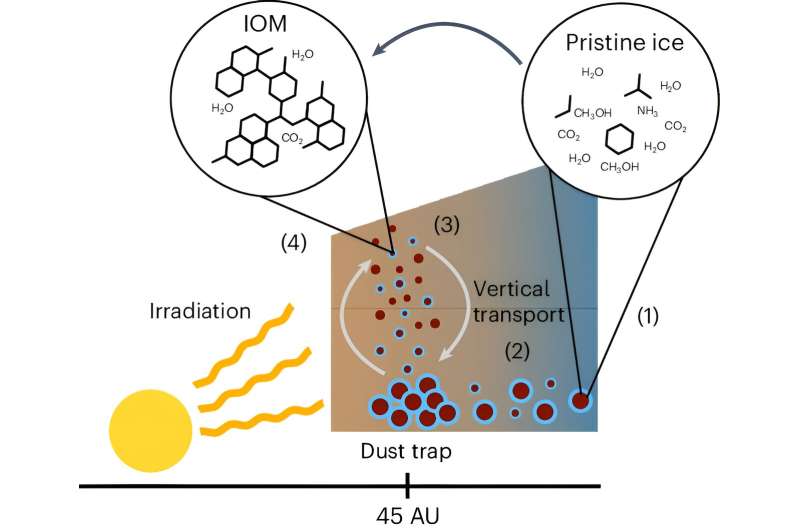This article has been reviewed according to Science X's editorial process and policies. Editors have highlighted the following attributes while ensuring the content's credibility:
fact-checked
peer-reviewed publication
trusted source
proofread
Astronomers explain rapid formation of organic macromolecules in protoplanetary disks around young stars

An international team of researchers led by the University of Bern has used observation-based computer modeling to find an explanation for how macromolecules can form in a short time in disks of gas and dust around young stars. These findings could be crucial for understanding how habitability develops around different types of exoplanets and stars.
Organic macromolecules are regarded as the building blocks of life, as they are of crucial importance for the life-friendly carbon and nitrogen composition of the earth.
Planetary scientists have long assumed that the organic macromolecules that make the Earth suitable for life come from so-called chondrites. Chondrites are rocky building blocks from which the Earth was formed around 4.6 billion years ago and which we know today as meteorites.
Chondrites are formed in the early stages by the accumulation of dust and small particles in the protoplanetary disk that forms around a young star. But until now, the question has been how the macromolecules formed that are present in these agglomerations of pebbles.
Researchers led by Niels Ligterink now present an explanation for this in a study that has been published in Nature Astronomy.
Ligterink, first author of the study, worked at the Space Research and Planetary Sciences division at the University of Bern until the end of June 2024 and is now an assistant professor at the Technical University in Delft.
Dust traps and radiation as key elements
"Macromolecular matter as such is responsible for the carbon and nitrogen composition of the Earth and provides the conditions for life," explains Ligterink. So far, however, it has not been clear where in space this macromolecular matter is formed.
For the current study, the research team, which was put together by Ligterink, combined two already known phenomena in its model. The first is the phenomenon that in the dust disk orbiting a young star, there are regions where dust and ice accumulate.
In such a dust or ice trap, the icy dust does not remain stationary, but moves up and down, and important mechanisms for the formation of so-called planetesimals, precursors and building blocks for planets, take place.
The second phenomenon involves the heavy irradiation, for example by stellar light, of simple ice mixtures. Laboratory research has indicated that very complex molecules of hundreds of atoms in size can be formed by irradiation. These molecules contain mostly carbon atoms and can be compared to black soot and graphene.
If, the researchers assumed, there were dust traps that were also exposed to intense starlight, organic macromolecules might well form there. To test their hypothesis, the researchers set up a model that allowed them to calculate different conditions.
Surprisingly rapid formation of macromolecules
The model showed that under the right conditions, the formation of macromolecules is indeed feasible in just a few decades. "We had expected this result, of course, but it was a nice surprise that it was so obvious," says principal investigator Ligterink.
"I hope that research will pay more attention to the effect of heavy radiation on complex chemical processes. Most researchers focus on relatively small organic molecules of a few dozen atoms in size, while chondrites, the building blocks for planets, contain mostly large macromolecules."
"It's really super cool that we can now use an observation-based model to explain how large molecules can form," says co-author Nienke van der Marel of Leiden University in the Netherlands. Eleven years ago, she and her colleagues were the first to convincingly demonstrate the existence of dust traps. She has been hooked on the subject ever since.
"Our research is a unique combination of astrochemistry, observations with the radio telescope observatory ALMA, laboratory work, dust evolution and the study of meteorites from our solar system."
In the future, the researchers plan to study how different types of dust traps react differently to radiation and moving dust flows. "This will help them learn more about the likelihood of life around different types of exoplanets and stars," concludes Ligterink.
More information: Ligterink, N.F.W. et al, The rapid formation of macromolecules in irradiated ice of protoplanetary disk dust traps. Nature Astronomy (2024). doi.org/10.1038/s41550-024-02334-4
Journal information: Nature Astronomy
Provided by University of Bern




















